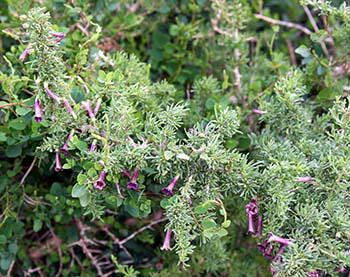Lycium afrum
Lycium afrum L.
Family: Solanaceae
Common names: kraal honeythorn (Eng.); kraaldoring, kraalkriedoring, slangbessie, bokdoring (Afr.)
Introduction
Coming from an economically important family of flowering plants, this is a robust, stiffly branched, moderate sized, thorny shrub, that may grow to be a small garden tree.

Description
Description
A thorny and stiffly branched shrub or small tree, that grows to a height of 2–3 m. The bark is pale creamy brown; branchlets armed with rigid spines 1-4,5cm long, often bearing the leaves and flowers.It has succulent-like, grey-green leaves, that are leathery and linear-oblong, 11–24 × 1–2 mm, tufted on short shoots and spirally arranged.

The tubular flowers are solitary, vary from white, mauve and purple, about 12–20 mm long, with the petal lobes surrounding about a quarter of the mouth of the flower; stamens inserted halfway up the tube and enclosed inside it. Flowering is in winter and spring, from July to October. The fruit is a nearly round, green, fleshy berry, ripening to orange red, then black in early summer, between October and November.
Conservation Status
Status
According to the website http://redlist.sanbi.org, checked on 18 March 2016, the conservation status of this plant is Least Concern (LC). There are no known threats to the species and the last assessment of this plant was done 2005/06/30.

Distribution and habitat
Distribution description
Lycium afrum is native to the Western Cape Province. It is found mostly on sandy, coastal flats and in shale renosterveld, from Lambert’s Bay to Caledon.
Derivation of name and historical aspects
History
The genus Lycium, pronounced ‘Ly’cium’, comes from the Greek word lykion, the name for a thorny tree with juice and roots used medicinally, from Lycia, a South-West region of Asia Minor. The species name afrum means ‘African’ or ‘of’ or ‘from Africa’, where this species originates.
Lycium is made up of about 100 species that occur in warm temperate regions throughout the world, but especially in the Americas. There are 23 species in southern Africa, which are widespread in all regions.
Ecology
Ecology
The flowers of this family are self-pollinating, but attractive to many insects, mainly ants. The berries are eaten by birds, who also disperse the seeds.
Lycium are browsed until the spines in the new growth hardens. They often form dense thickets and increase on land that is overgrazed. Their thorns also give protection to other plants that grow among them.

Uses
Use
According to Wikipedia, plants of the genus Lycium have been known to European herbalists since ancient times, and species were traded from the Far East to Europe by the Romans, for example via Ariaca and the port of Barbarikon near today’s Karachi, as mentioned in the Periplus of the Erythraean Sea. In his Naturalis historia, Pliny the Elder describes ‘boxthorn’, a common name for many species, as a medicinal plant recommended as a treatment for sore eyes and inflammation, as well as does Pedanius Dioscorides in his P. Dioscoridae pharmacorum simplicium reique medicae.
There are no records for this species being used medicinally in South Africa. The fruits are said to be edible, but other species are poisonous; so they should be treated with caution. In earlier times the thorny branches of many Lycium were used to make cattle enclosures (kraals) to keep stock animals safe from predators at night.
Growing Lycium afrum
Grow
Lycium afrum makes a good garden subject. This plant may be used for security against a fence because of its thorny branches. Its bluish purple flowers make a nice show when they fill the bush during the flowering season, followed by the attractive berries that will give their own show once the flowers are finished. This plant will do well in full sun, it is tolerant of winds and drought, and will tolerate sandy soils.
Most species from the Solanaceae family grow easy from seed. This plant produces fleshy berries and the flesh has to be cleaned off before the seeds can be sown and germinate easily. Seeds can be sown under greenhouse conditions in Spring (August-October). It will also very easily grow from suckers. It is unclear if both sexual and vegetative reproduction would occur in a naturalised situation.
References
- Leistner, O.A. (ed.). 2000. Seed plants of southern Africa: families and genera. Strelitzia 10. National Botanical Institute, Pretoria.
- Manning, J. 2007. Field guide to Fynbos. Struik Publishers, Cape Town.
- Manning, J. & Goldblatt, P. 2012. Plants of the Greater Cape Floristic Region 1: the Core Cape Flora. Strelitzia 29. South African National Biodiversity Institute, Pretoria.
- Coates Palgrave, K. 2002. Trees of southern Africa. Struik, Cape Town.
- Smith, C.A. 1966. Common names of South African plants. Memoirs of the Botanical Survey of South Africa No. 35. Government Printer, Pretoria.
- Plants For A Future: http://www.pfaf.org/user/Plant.aspx?LatinName=Lycium+afrum accessed 11 April 2016
- WIKIPEDIA: https://en.wikipedia.org/wiki/Lycium_afrum and https://en.wikipedia.org/wiki/Lycium accessed 11 April 2016
Credits
Sisanda Velembo
Kirstenbosch National Botanical Garden
April 2016
Plant Attributes:
Plant Type: Shrub
SA Distribution: Western Cape
Soil type: Sandy
Flowering season: Spring, Winter
PH: Acid
Flower colour: Purple, White, Mauve/Lilac
Aspect: Full Sun
Gardening skill: Average
Special Features:
Horticultural zones









Rate this article
Article well written and informative
Rate this plant
Is this an interesting plant?
Login to add your Comment
Back to topNot registered yet? Click here to register.